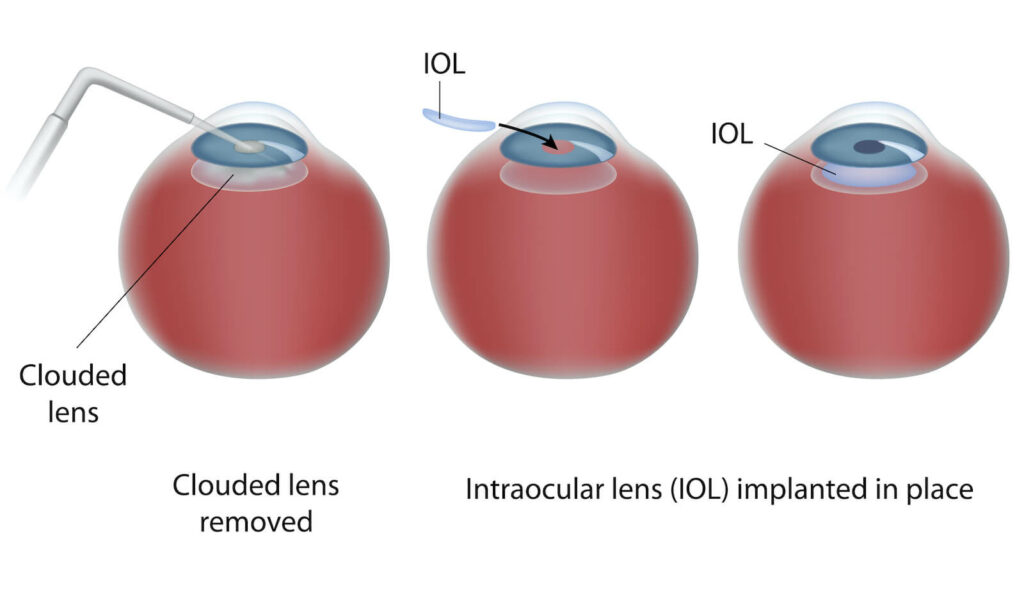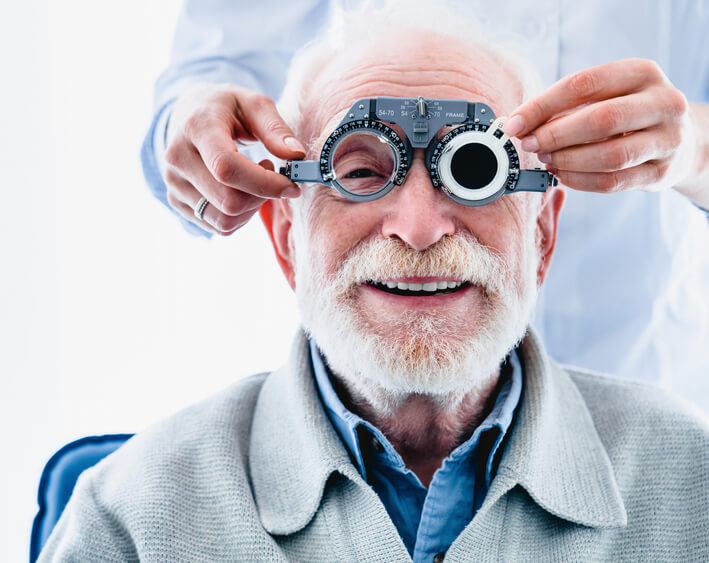Cataract Surgery
By placing a small incision in the eye, our skilled surgeons remove the cataract by a process called phacoemulsification, during which the surgeon dissolves the cataract. This method is commonly regarded as the laser technique, but actually it uses sound waves to disintegrate the cataract and then vacuum the microscopic particles from the eye. Lasers may be used after cataract surgery to eliminate any residual cloudiness.

At the same time, the cataract is removed, the lens of the eye is replaced with a clear lens implant, which is inserted through the same small incision. With the new lens in place, the eye can function properly and normal vision is restored.
Monofocal lenses are used in the majority of cataract procedures. These lenses have the advantage of excellent quality distance vision under a variety of lighting conditions. Since these lenses have a fixed focal point which is generally set for distance vision, reading glasses are typically required for good near vision. For patients willing to use reading glasses for near tasks, these lenses are an excellent choice. Several million lenses of this variety have been used for decades with an excellent safety record. Recent refinements in the optical quality of these lenses have allowed an even higher quality of vision than previously achievable.

The new multifocal and accommodating IOLs (premium lens options) offer the possibility of seeing well at more than one distance, without glasses or contacts.
The No-Stitch/No-Needle Technique
With the no-stitch cataract removal technique, the incision is very small and angled in a way which will enable it to close on its own. The outward pressure from the fluid within the eye acts as a seal, so there is no need for stitches. The vast majority of cataract surgery is done using anesthetic gel, avoiding the need for any type of injection which allows faster vision recovery and less risk.
Once the incision is made, the surgeon dissolves the cataract by phacoemulsification, inserts an artificial lens through the same incision and allows pressure to seal the incision naturally.
Quick Recovery
Small incision, no-stitch cataract surgery enables the eye to heal fast and reduces recovery time significantly.
In addition, post-operative activities are practically unlimited. With local anesthesia options, you can walk right out of the Surgery Center shortly after surgery and perform most of your daily functions with no restrictions. Many patients are able to return to work or sports within days instead of weeks or months, as was common with older surgery methods.
Within three years after cataract surgery, some patients may need another procedure, a YAG capsulotomy, to open the cloudy posterior capsule.
While not everyone is a candidate for no-stitch surgery, at Montgomery Eye Physicians, most patients receive this advanced surgical technique and are able to resume their daily activities quickly and confidently.

State-Of-The-Art Technology
We take great pride in the exceptional service our patients receive. Our highly skilled surgeons have many years of experience and use only the newest, most advanced technology at the Montgomery Eye Surgery Center. Our goal is to make sure you receive high quality, individualized attention in a friendly and caring environment.
If you have any questions please call us at 1-800-763-EYES.
Premium Lens Options
Are you seeking clear vision without the hassles of reading glasses or bifocals? Until recently, this was not an option, but now with the introduction of the premium intraocular lenses, the possibility of being glasses-free after cataract surgery has arrived!
There are several premium lens options available at Montgomery Eye Physicians. We encourage you to schedule a consultation and discuss your visual desires and our experts will pair you with the right IOL for your individual needs.
Monofocal IOLs
Monofocal IOLs can provide clear vision at one range of distance, either near, intermediate, or far. These standard lenses offer crisp, clear vision at the set focal range.
However, glasses or contacts are still required for activities requiring clear vision for the other ranges. For example, if you chose to have your distance vision corrected with a monofocal IOL, you would still need to wear glasses for tasks that require clear near or intermediate vision, like reading or using the computer.
Monofocal IOLs are a budget-friendly option covered by most insurance plans. By replacing the natural cloudy lens, they effectively treat cataracts and related symptoms like glare, halos, and blurred vision.
Though monofocal IOLs only correct a single range, unlike advanced lenses, they still dramatically improve sight after cataract surgery.
Multifocal IOLs
Multifocal IOLs are advanced lenses that can correct vision at multiple ranges – near, intermediate, and far. Concentric rings etched onto the lens surface allow your vision to be clear at varying distances.
This technology provides a greater range of vision. Multifocal IOLs can allow you to significantly reduce the need for glasses and contacts after cataract surgery.
Though they carry a higher cost than basic monofocal lenses, multifocal IOLs have the benefit of providing you with greater visual freedom. They are ideal for active individuals who desire crisp vision at all distances and those who want to reduce dependence on visual aids.
By correcting presbyopia in combination with cataracts, multifocal IOLs are a premier solution for sharp sight.
Toric IOLs
Toric IOLs correct for astigmatism in addition to restoring vision compromised by cataracts. For those with higher levels of astigmatism, toric IOLs can provide more optimal vision correction than other types of IOLs.
Your eye doctor at Montgomery Eye will tell you if a toric IOL is the best option for you based on your eyes and the amount of astigmatism. Though toric IOLs come at a premium cost, they provide crisp, clear sight by addressing two underlying vision issues.
Extended Depth of Focus IOLs
Extended depth of focus IOLs, which are sometimes called EDOF IOLs, utilize unique technology to produce a continuous range of sharp vision rather than multiple focal points. This extended depth of focus allows you to have clearer vision with fewer visual disturbances.
EDOF lenses also typically provide better nighttime visibility with reduced glare and halos from oncoming lights. Extended depth of focus IOLs have unique technology to produce smooth, seamless vision from far to near ranges.
Unlike some other lenses that have clear vision at set distances but fuzzy spots in between, EDOF lenses provide crisp sight that transitions gracefully as you focus on objects at different distances. With advanced technological design, they stand apart from standard monofocal and basic multifocal lens options.
For those undergoing cataract surgery who want a lens that can correct presbyopia, provide greater visual freedom, and eliminate cataracts, an EDOF IOL may be a perfect choice.
Do you want to learn which IOL may be best for you? Schedule an appointment at Montgomery Eye in Montgomery, AL, today!
